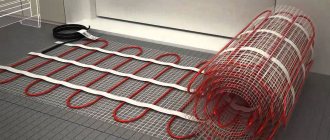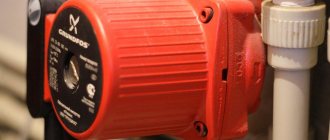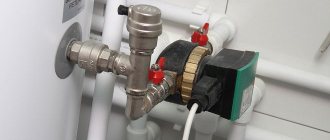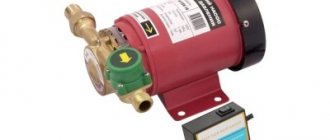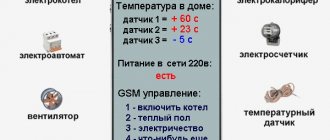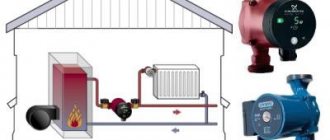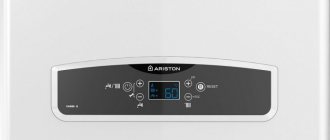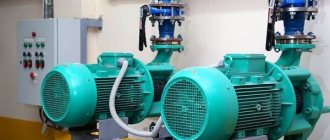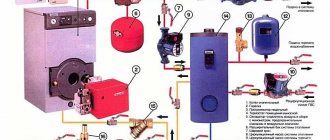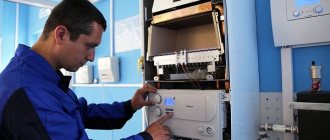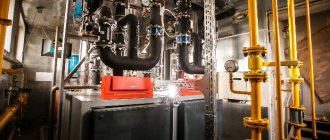The circulation pump is a fairly important element of a modern heating system. This device ensures forced movement of the coolant through the pipeline and increases the productivity of the specified equipment.
It is worth noting that water pumps have a number of advantages, among which the following characteristics are of particular importance:
- The ability to maintain a constant temperature regime regarding the heating substance.
- Quite low level of energy resource consumption.
- High degree of reliability.
- Easy to use.
The main functional task of the circulation pump is to overcome the resistance of the pipes. As a result of the operation of this unit, the coolant maintains a constant speed of movement, which implies uniform heating of heating devices, as well as effective heat transfer.
The device in question can be designed in one of the following variations:
- pump equipped with a wet rotor;
- pump equipped with a dry rotor;
The first type of unit involves immersing the rotor and impeller directly into the coolant liquid medium. This determines the presence of such properties in the structural elements of the pump as resistance to corrosion processes. Thanks to the mentioned quality, the unit itself is characterized by a high degree of reliability, along with a long service life.
Speaking about the disadvantages of the described unit, we should mention the rather low efficiency. This circumstance does not allow the operation of such devices in relation to heating systems operating over a large area.
The second type of water pump for heating eliminates contact of individual structural parts with water. This makes it possible to pump fairly large volumes of liquid. In addition, a device with a dry rotor has a higher efficiency, which improves heating efficiency.
The positive characteristics inherent in circulation pumps of both types indicate the advisability of using these devices to optimize the performance of heating systems. However, it should be borne in mind that maximum effect can only be achieved by installing a properly selected pump.
It is important to note that the procedure for choosing a water pump involves not only clarifying its positive and negative qualities. This event also requires performing appropriate calculations that will help determine the required parameters of the unit.
Equipment calculation
Before you begin calculating a circulation pump for heating, it is necessary to study the functions performed by the device, since they are the determining ones when carrying out this activity:
- The water pump pumps coolant, the volume of which depends on the area of the heated room.
- The device overcomes the resistance of pipes and fittings.
Based on this information, the heating pump is calculated.
Power
Based on the need for thermal energy in the heated room, it is necessary to clarify the operating power that the purchased device must have. This requires the use of the following formula:
G = Q/(1.16*DT).
The following quantities and values are used here:
Q is the amount of thermal energy consumed by the heated room.
DT is an indicator of the temperature difference between the coolant circulating in the forward and return circuits. This value is constant, but its value depends on the type of heating:
- twenty degrees - conventional heating equipment;
- ten degrees - low temperature heating;
- five degrees - “warm floor” system;
1.16 - specific heat capacity. We are talking about ordinary water. In cases where there is another coolant in the system, you should substitute the value inherent in it.
It is worth noting that the calculation of the power of the water pump can be carried out using another formula:
G=3.6*Q/(c*DT).
c - means the specific heat capacity of the liquid that circulates in the pipeline.
The result of such calculations is displayed in kg/h. However, quite often the performance of the unit in question is indicated in cubic meters. In order to display the resulting value in m3/h, you should divide it by the density of water.
Calculation example
If the area of the house is 150 square meters, then the heat requirement of such a room will be 15,000 watts. Since the building is heated using a standard heating system equipped with conventional radiators, the temperature delta will be equal to 20 degrees.
By substituting the available data into the appropriate formula, you can obtain the value of the desired quantity:
15000/(1.16*20)=646.55 kg/hour.
When converted to cubic meters, it turns out:
646.55/971.8=0.665 m3/hour.
Pressure calculation
If a circulation pump is installed during the installation of the main heating equipment, there is a need to calculate the pressure relative to the specified apparatus. This activity is carried out using the following formula:
H=(R*L +Z')/p*g.
Here are the following quantities and values:
R is the resistance indicator relative to the straight section of the pipeline.
L is the length of the pipeline itself.
Z - resistance caused by various obstacles present in the path of the circulating substance (fittings, fittings).
p is an indicator of the density of the coolant at a specific temperature.
g is an indicator of acceleration relative to free fall.
When calculating a pump installed in an already functioning heating system, approximate data are used:
H=R*L*ZF
The following parameters are present here:
R is the resistance of a straight pipe. The approximate value of this value is 100-150 Pascal per meter. It should be displayed in pressure readings. Then it will take the following form: 0.010-0.015 meters per meter of pipeline.
In this case, you need to start from the maximum value. Such actions will not have a negative impact on energy consumption.
L is the total length of the pipes. If we are talking about a two-pipe heating system, the duration of the supply circuit and the return circuit should also be taken into account.
ZF is a multiplication factor that greatly simplifies the process of performing calculation operations. Its meaning depends on the following circumstances:
- if the system is equipped with conventional ball valves that prevent a decrease in clearance, as well as fittings with appropriate dimensions, the multiplication factor is 1.3;
- when the system contains a throttle or thermostatic regulator that breaks the circuit, an additional value of 1.7 is applied;
Calculation example
If the total area of a square room is 150 m2, then the length of each wall will be 12.25 meters. Consequently, the total length of the pipeline is quite simple to calculate: 12.25 must be multiplied by 4, the result is 49 meters.
It is worth noting that the chokes are mounted directly on heating devices. In this case, rupture of the main ring should be completely excluded.
By substituting the available values into the appropriate formula, you can determine the desired pressure:
0,015*49*1,3=0,9555.
It is important to note that the purchased circulation pump must have a headroom reserve, the value of which is at least ten percent.
A circulation pump is a mandatory element of a water heating system for a house with forced or combined (combined) circulation. And in order for it to work effectively, it is necessary to choose the right model with the most suitable characteristics. From this article you can learn how to independently select a circulation pump for a heating system.
Knowledge needed for calculations
In order to correctly understand and produce a complete algorithm for calculating the circulation pump of a heating system, you should be able to correctly start from a certain value, the correctness of which will not raise doubts. To do this, you first need to open the passport of the room in which the equipment will be installed and find out its total area. For an example of calculation, we will take a private house with a total area of 300 square meters.
Next, you need to determine all the values that will be needed for the calculation, these are 3 main parameters:
- Qn shows the heat power (kilowatts);
- Qpu shows the power of pump movement (more precisely, this value will show V of the coolant supply for the selected room, measurements are taken in meters per hour)
- Hpu value shows the pressure power that is needed to overcome multidirectional systems
To calculate heat, you will need all these quantities. For each home, there are special standards that a heating source must have. In other words, a certain norm of formulas that is used further.
In order to find out the power, there is a formula: Qn=Sn*Qyd/100.
The total area of the proposed premises is known; it is three hundred square meters. The second indicator depends only on the type of building: in an apartment building the indicator is equal to seventy Watts per square meter, in the case used in the example (a separate building) it is one hundred Watts per square meter. Translating all the values into the formula, it turns out: 300*100/1000=30KW. As a result, it turns out that the power of the room heating device will be thirty kilowatts.
There is another method by which you can make the calculation. The size of the room to be heated, as well as the required power of the heating unit, can be found below:
- 5 KW - V premises of an obsolete building 70-150 sq.m, V premises of a new building 60-110 sq.m;
- 10 KW - V premises of an obsolete building 150-300 sq.m, V premises of a new building 130-220 sq.m;
- 20 KW - V premises of an obsolete building 320-600 sq.m, V premises of a new building 240-400 sq.m;
- 30 KW - V premises of an obsolete building 650-1000 sq.m, V premises of a new building 460-650 sq.m;
- 40 KW - V premises of an obsolete building 1050-1300 sq.m, V premises of a new building 650-890 sq.m;
- 50 KW - V premises of an obsolete building 1350-1600 sq.m, V premises of a new building 900-1100 sq.m;
- 60 KW - V premises of an obsolete building 1650-2000 sq.m, V premises of a new building 1150-1350;
Formula V of a building or apartment, V is calculated by multiplying its H by S. (V=S*H):
- V is the volume of the entire room;
- S is the total area that is heated;
- H is the height of the room;
In the example chosen, the height is 2.5 meters. The total total area in this case will be equal to the formula. 300*2.5=750 meters cubed. Based on the data above, this is exactly 30 kilowatts.
Selection of a pump according to its main characteristics
The main technical characteristics of any heating pump are:
These parameters must ensure sufficient coolant circulation for efficient transfer of thermal energy from the boiler to the radiators, therefore they must correspond to both the power of the system itself and the hydraulic resistance in it during coolant circulation. Therefore, in order to make the correct selection of a pump for a heating system, you need to know both of these quantities.
Their exact calculations, which are used by specialists, are quite cumbersome and complex. Therefore, when making your own selection, you can use simplified calculations using the fairly simple formulas given below and recommended average indicators that will allow you to select the optimal characteristics of the circulation pump. Moreover, almost anyone can make such calculations.
How to determine the power of the heating system and the required pump flow
The required thermal power of the heating system depends on the amount of heat required for comfortable heating of the house and is directly dependent on its size and the thermal insulation properties of the materials from which its walls, roof, ceiling, floor, windows, and doors are made. The size of the house or its heated part is not difficult to calculate. All you need is a tape measure and a calculator.
It is more difficult to accurately calculate heat loss through external structures, since it is necessary to take into account their material, thickness and design features. Therefore, for a simplified calculation, you can use the recommended average values of 1-1.5 kW of thermal power per 10 m2 of a heated room with a ceiling height of up to 3 m. If the room is well insulated, then a lower value can be used, and if it is not insulated or insufficient, then it is better use a larger value.
For example, for a well-insulated house with an area of 120 m2, approximately 12 kW of thermal power will be needed. If the selection of a circulation pump is carried out for an existing heating system with natural circulation, then the power of the installed boiler can be taken into account.
Calculation of required pump performance
Having decided on the thermal power of the heating, you can begin to calculate the flow (performance) of the circulation pump. To do this, you can use two simple formulas. The first of them: P = Q/(1.16 x ΔT),
(kg/h or l/h) Where:
- Q
– previously calculated thermal heating power (W); - ΔT
is the difference between the temperature of the supply pipe and the return pipe, which for conventional systems is usually within 20 o C, and for heated floors - about 5 o; - 1.16
– coefficient taking into account the specific heat capacity of water,
W
×
h
/
kg
×
o C
(for other coolants (antifreeze, oil) it will be slightly different and, if necessary, it can be found in reference books or on the Internet).
Another formula: P = 3.6 x Q/(c × ΔT),
(l/h) Where:
c
– heat capacity of the coolant (for water
4.2 kJ/kg×°C)
. Using any of these formulas, it can be determined that, for example, a two-pipe system with a thermal power of 12 kW will require a pump with the following performance (flow): P = 12000/(1.16×20) = 517 l/h or 0.5 m3/ h
Calculation of the required pressure to overcome hydraulic resistance
In order to select a circulation pump for a heating system, in addition to its performance, it is necessary to determine its pressure (pressure) that it must create in order to overcome the existing hydraulic resistance. But first you need to know the magnitude of this resistance. To simplify its calculation, you can use the formula: J = (F+R× L)/p× g
(m) Where:
- L
– length of the pipe line to the most distant radiator (m); - R
– specific hydraulic resistance of the straight pipe section (Pa/m); - p
– coolant density (for water – 1000 kg/m3); - F
– increase in resistance in connecting and shut-off valves (Pa); - g
– 9.8 m/s 2 (gravitational acceleration).
The exact values of R and F for different pipes, connecting and shut-off valves of different types can be found in the reference literature. For our simplified calculation, we can use the average data of these quantities obtained experimentally: R
— 100-150 Pa/m (the larger the diameter of the pipes and the smoother their internal surface, the lower the resistance);
F
can be taken depending on the type of reinforcement:
- additionally up to 30% of losses in a straight pipe - for each connecting fitting in this section;
- up to 20% - for a three-way mixer or similar devices;
- up to 70% - for the regulator.
You can also use the formula proposed by specialists from the well-known pump manufacturer Wilo for calculation: J = R
×
L
×
k,
m Where:
k
is a coefficient that takes into account the increase in resistance in control and shut-off valves:
- 1.3 – simple heating systems with a minimum amount of fittings;
- 2.2 – in the presence of control valves;
- 2.6 – for complex systems.
It is necessary to take into account that if circulation in a system with two or more distribution circuits (branches) is provided by only one pump, then to select its pressure, their total resistance should be taken into account. If each circuit is provided with a separate pump, then the calculation of the thermal power and resistance of each of them must be performed separately. The number of floors of a building does not play a big role when calculating the pressure. Because in a closed heating system, the liquid column of the supply line is balanced by the return column.
How to choose a circulation pump based on the data received
Having completed the calculations and determined the main parameters (flow and pressure), we will proceed to selecting a suitable circulation pump. To do this, we use graphs of their technical characteristics (B), which can be found in the passport or operating instructions. Such a graph should have two axes with pressure values (usually in m) and flow (productivity) in m3/h, l/h or l/s. We plot the data obtained during the calculation on this graph in the appropriate dimension and at their intersection we find point (A). If it is above the pump characteristic graph (A3), then this model is not suitable for us. If the point falls on the chart (A2) or is below it (A1), then this is a suitable option. But it is necessary to take into account that if the point is located significantly below the graph (A1), this means that the pump will have an excessive power reserve, which is also impractical, since it will consume more electricity and its cost will also be higher than the model, characteristics graph which will be as close as possible to our point.
There are pump models that have not one, but 2-3 speeds. The graphs of their characteristics will have not one, but, accordingly, 2 or 3 lines. In this case, the selection of the pump must be done according to the schedule of the speed that will be used or taking into account all lines if all speeds will be used.
Calculator for calculating underfloor heating and its installation
There are purchases that are made not for a year, but for decades. A heated floor system that provides a comfortable microclimate in the house all year round is one of them. Every person who is going to install heated floors with his own hands wants to make the right choice and accurately calculate all the costs - and this is natural.
If you are new to the construction industry and doubt whether you can carry out all the calculations correctly, use a special online calculator. Thanks to it, you can evaluate the range of upcoming work and the optimal amount of material for a heated floor. Using it is very simple. To do this, you need to select “Calculation of heated floors” in the “Construction calculators” section and enter all the data that the site requests.
The automatic program instantly calculates the data necessary to create a project:
- power of the floor heating circuit (total and W/m²);
- pipe length;
- volume and thickness of mortar for finishing screed;
- optimal amount of sand, cement, fiber and plasticizer;
- feed speed, water consumption, etc.
The coefficient method is used as the basis for the calculator’s operation: standard, pre-made calculations are taken into account, changing depending on the changes made by the user. When issuing results, the type of floor covering, air temperature, step of laying heated floors under tiles or laminate and other parameters are taken into account.
For an approximate calculation of power, an analysis of heat loss is carried out, its ratio taking into account the total area and the average temperature in the room during the cold season. Based on this data, the builder, whether professional or amateur, must mark the line of passage. Power is one of the most important criteria for choosing a suitable installation technology.
- in rooms characterized by low temperatures and high humidity, the specific power indicator is 170 W/m²;
- for rooms with low humidity, a power of 130-140 W/m² will be sufficient;
- if a warm floor is used as the main heating of the room, the optimal indicator will fluctuate between 160-220 W/m².
An unmistakably designed underfloor heating scheme is the key to long-lasting and efficient heating. Thanks to our online underfloor heating calculator, you can create a reliable heating system that will last for decades.
When planning to lay it, you need to take into account the further expansion of concrete after heating. When choosing a thermal insulation option, experts recommend giving preference to expanded polystyrene or penoplex. Further:
- After it, a damper tape is laid to compensate for the expansion.
- A reinforcement mesh is laid to which the circuit pipes are attached.
- At the final stage, the structure is filled with concrete mortar.
The peculiarity of this technology is heat retention. Otherwise, it may flow through the cracks to the lower floors.
A distinctive feature of this method is the absence of any screed. During installation, the coating rests on aluminum plates. Between them and the floor itself there is a gasket, cardboard or polyethylene. Those planning to install such a floor should take into account some nuances:
- It is important to use additional insulation, and place polystyrene mats on it.
- It is possible to install a polystyrene system floor when heat-distributing plates and pipes are placed in the connectors.
- The underfloor heating heating system is installed on concrete or potential floor.
READ MORE: Is it possible to lay linoleum on linoleum? How to prepare a floor for installation of a new coating
? It is a good option for rooms with low ceilings and insufficiently strong floor slabs, when it is not possible to install a concrete screed.
Suitable for prefabricated or so-called “panel” houses. You can use chipboard panels with pipe channels or heat-conducting plates that alternate with layers of chipboard.
- Each element is attached to the base with a self-tapping screw every 2 cm.
- The plates need to be placed in the gaps and separated.
- The pipes are installed and, upon completion, covered with floor covering.
This option is intended for rough wooden floors on joists when you need to create an additional heating source.
The key thermal and hydraulic parameters of the online calculator are designed for a heated water monolithic floor using cement-sand mortar. In order for the result to best meet your expectations, you must take into account that heated floors cannot always be used as the main source. This is preferable for regions with a southern climate. In addition, then it is impossible to do without the additional use of energy-efficient materials.
The calculations obtained on the site will be useful to those who are planning to install a heated floor on their own in a private home. As for apartments, this method is not always suitable for them. If you have autonomous heating, it will be possible to regulate the heating, which cannot be said about the possibilities with a central heating system.
Floor heating will allow us to enjoy a high level of comfort at low water temperatures in the system. Since the entire floor surface becomes a radiant surface, it is possible to give the consumer the same sense of well-being even if the air temperature is approximately 2°C lower. The consumer feels that he is living in an environment that is heated to 20 ° C - 21 ° C, in fact the thermometer only shows 18 ° C.
This low inlet water temperature will also allow the use of alternative energy sources (solar energy using storage tanks, energy generated by heat pumps or extraction from industrial processes). The insulating panel or impact plate system board performs an important function in soundproofing as it absorbs noise between different floors.
What else influences the choice
The selection of a pump for a heating system, in addition to its basic parameters (pressure and flow), can be influenced by some other factors, for example, such as: manufacturer, workmanship, durability, maximum operating temperature, cost, etc. They are often related. High-quality pumps from reliable ones, "Wilo", "DAB", "Lowara", "Ebara" and "Pedrollo", usually have a high cost. Chinese or domestic models are usually much cheaper, but there is no guarantee of their reliability and long-term operation. Here everything depends on personal choice: either a high-quality, reliable product at a higher price or a cheaper, but less reliable circulation pump, which may have to be changed soon. Sometimes, to save money, they buy used Grundfos or Wilo. Often, they work normally longer than new Chinese ones, but if purchased from trusted specialists who can give a certain guarantee.
Another technical characteristic parameter that may be important when choosing a circulation pump is the maximum permissible operating temperature, which should also be in its passport or operating instructions. This is especially important if the pump is supposed to be installed in a heating system with a solid fuel boiler on the supply pipe. The maximum permissible temperature for its operation, in this case, should be at least 110 o C. If, however, it is installed on the return line, then this parameter is not so important, since the coolant temperature in this place rarely exceeds 70 o C.
The heating system in a private or country house needs a special pump that will help the coolant circulate through the pipes. Thanks to this circulation pump, it is possible to ensure that all rooms in the house are heated in the most uniform manner. Installing such a device requires some calculations. The calculation of a heating pump may depend on some specific circumstances. First, you need to decide on the type of pump. The pump can be “wet” or “dry”. Their difference is that the first pump has a working area under a layer of water, that is, in the pumped medium.
This pump does not require additional lubrication or moisturizing. However, it must be taken into account that water pressure or resistance can largely influence the functional power of the unit. Let's figure out how to calculate a heating pump.
Heating pump power calculation
How to calculate the heating power of the pump? When choosing a pump for a heating system, you need to pay attention to the operating point from which its operation begins. It will be installed at the same point. Water flow and pressure will be indicators characterizing the position of the pump. To measure water flow, a value such as cubic meters of water per hour (pump speed in a heating system) is used, and pressure is measured in meters. Such indicators largely depend on what characteristics the pump has.
When calculating a heating pump, it is best to choose an option in which the power of its starting point will be equal to the power consumed by the heating system itself.
This pattern can only be tracked on a special graph. This procedure will help determine if a particular pump is suitable for your heating system based on its power ratings.
Below is a formula that will help you find out the power of the heating circulation pump:
P2(kW) = (p * Q * H) / 367 * efficiency
P – water density level;
Q – water flow level;
H – water pressure level.
This is how the heating pump power is calculated.
Calculating the pump performance level
In order to calculate the circulation pump for heating, you will need to use the following formula:
Q = S * Qsp / 1000
S – heated area;
Qsp is the level of specific heat energy consumption;
This figure will be slightly different in apartments and private houses. In apartments, the specific heat consumption is about 70 watts per square meter of area, and in private houses this figure can reach 100 watts per square meter.
Calculating pipes
The following types of pipes are used for heated floors (more about pipes for heated water floors):
- metal-plastic is an economical, environmentally friendly option. It is most often used in the construction of heated floors;
- polypropylene. The pipes are cheap and have good performance. Disadvantage: large bend radius. When laying a snake pipe with a cross-section of 2 cm, the distance between adjacent turns will exceed the required maximum of 30 cm;
- cross-linked polyethylene. Performance properties are good. Cons: the price is higher than the two previous materials; pipes are too soft and flexible, installation is more difficult and takes longer;
- copper. Durable, corrosion-resistant option. The pipe bends well, the entire contour can be laid in one piece, there is no need to weld sections. Cons – expensive; Copper flooring is difficult for an amateur to install.
The pipe cross-section is usually chosen to be 16 millimeters. In this case, the pipe heats up about 10 centimeters on both sides.
When calculating pipes for water heated floors, you should take into account: this is not an electric cable, which heats equally over its entire length. As it moves away from the boiler, the coolant cools down.
The efficiency of the circuit is also affected by hydraulic resistance. This determines the maximum permissible length of the circuit (100 meters).
The preferred installation pattern is a spiral. When laying in a snake pattern, keep in mind that the part of the circuit farthest from the collector will heat up worse than the part closest to it. A compromise option is a corner snake: the pipe turns in the opposite direction after passing not one wall, but two, including the corner. With this scheme, the first turn should be located in the coldest corner.
Regardless of the size of the rooms, each has its own contour. First of all, this applies to rooms with different temperature conditions (for example, a living room and a veranda will be heated differently).
- the pipe is placed at a distance from the wall of up to 25 centimeters (at least 8).
- the difference between the lengths of adjacent turns is no more than 15 meters;
- circuit length is up to 100 meters, heated area is up to 20 square meters. If the room is larger, put 2, 3, etc. contours;
- minimum pressure in the manifold – 20 kilopascals;
- water flow in the circuit is from 0.03 to 0.07 liters per second.
The calculation of the installation step of a water heated floor is carried out depending on the climate in the area and the characteristics of the room. In any case, the step between turns should be no more than 30 centimeters. About 15 cm if the temperature in winter is down to -22, 10 centimeters if lower. In places of greatest heat loss, the step is smaller.
L= S/a x 1.1,
READ MORE: Infrared heated floor under tiles
where S is the heated area in square meters. m, a – laying step, 1.1 – ten percent margin for turns. To the resulting figure you should add 4 meters (two each for connecting the direct pipe and the return pipe to the collector).
For each circuit this figure is calculated separately. It is advisable to make the circuit as a single pipe. The total length of the pipes is the sum of the lengths of the circuits.
Cavitation in the heating system and water supply system
Cavitation is a process during which steam molecules are formed in a heating installation due to a decrease in pressure. This process occurs if the fluid flow rate in the pipes decreases or increases.
If the heating system is characterized by temperatures that are too low or too high, this phenomenon can have a negative effect. The steam that is formed collects in bubbles, and if they burst, they thereby cause damage to the material from which the pipes or other components of the heating system are made.
A correctly selected device and correctly calculated the power of the heating circulation pump will guarantee that the operation of the heating system and water supply system will be most efficient.
If you are unable to independently carry out such operations as how to calculate a heating pump, or you doubt their correctness, then it is better to entrust this matter to a professional in this field. A specialist will not only help with choosing a pump or making calculations, but will also directly install the pump.
Calculator for calculating underfloor heating and its installation
A sense of well-being is one of the most important things to consider when installing heating.
Of great importance is the development of technology that has been observed in recent years in the field of environmental comfort, and especially in the sector of heating and control systems: a new generation of radiant floor heating has been developed thanks to the low temperature of the water in the system, which has led to significant energy savings.
Radiant floor heating has been around for a very long time, but it only gained final popularity after improvements in certain factors, such as insulation, spatial control systems and synthetic pipes, which completely replaced iron and copper pipes.
With the development of control systems and electronic control, it was possible to change the technical concept and eliminate sources of faults. With this improvement, the radiant floor heating system has been rebuilt and given the opportunity to take its rightful place in a modern installation.
This modern technology has allowed us to eliminate excessively high temperatures in the floor, which caused poor circulation and swelling of the legs.
With countless studies on heating systems, it has been proven that radiant floor heating system, which uses modern technology, provides comfort and coziness to the human body higher than conventional heating systems. A comfortable feeling is achieved due to a constant temperature, which is distributed throughout the entire area of the heated room.
Traditional heating scheme It is known that the speed of hot air and, above all, cold air and the excess of uneven temperature distribution, increase the feeling of poor thermal comfort of individuals and, therefore, the burden of their health. This completely eliminates air currents that cause strong and harmful temperature fluctuations in our body.
If the radiant surface is made of flooring, this system can keep the air temperature lower while maintaining the same feeling of comfort. The lower air temperature, in addition to improving its quality, eliminates the feeling of difficulty that sometimes arises when we enter an overheated environment. Heating imbalance
For large surfaces with low temperatures, air draft is practically removed and the air in the environment is less dry. This system can create a natural coziness and thus avoid heat leakage and high temperature changes, as occurs with traditional heating systems. Research has shown that people like warmth near their feet and bother them around their heads.
The low surface temperature significantly limits the flow of dust and prevents the classic dark streaks on walls, thereby eliminating the need for new wall painting: it removes the so-called chimney effect, which is associated with air that, when in contact with a very warm surface, such as the surface of a radiator, quickly rises and falls again and settles on the cold surface.
The benefits of a radiant underfloor heating system bring great relief to people who suffer from allergies and have health problems with the respiratory tract - asthma, allergies, etc.
This is comfort for the whole family, including pets such as dogs and cats.
The underfloor heating system consists of thermal insulation panels, known as system boards, which serve for quick and precise installation of pipes and have a thermal and sound insulating function.
To install an underfloor heating system, we recommend using pipes (PEXb, PEX/Al/PEX), whose feature is durability and prevent phenomena such as decoration and corrosion.
In addition, there are central distributors and three-way mixing valves, thermoelectric heads, which are actuated by a thermostat and which control the temperature in the rooms and are located on the distribution combs. All these varieties are placed in a distribution cabinet so as not to disturb the aesthetic character of the room.
READ MORE: Features of connecting a heated floor to a thermostat and electricity
The heat regulation, which is implemented separately for each circuit, allows us to control the temperature in each room at any time, which definitely exceeds the limits of older heating circuits.
In winter, the water entering the heating line is between 30 ° C and 40 ° C. The temperature from the piping system in the floor takes the underlay layer and then the floor, the surface of which reaches a temperature of 25 to 29 ° C. The heated floor radiates heat in a radiant manner , which is very convenient and economical.
Automation of pumping equipment
To function properly, such pumps must consume electricity. Today, electricity is not cheap, so many people are thinking about how to make the pump more economical in terms of energy consumption.
Installing a heating system in a private home is a necessary and extremely important task when you want to create the most comfortable temperature conditions for living in it. The most efficient heating unit is a piping with forced circulation of coolant through the main line.
To achieve this task, the system should be retrofitted with a pumping unit. The only problem is that it is necessary to select such equipment in terms of performance, because the efficiency of the entire circuit depends on this. You will learn how to correctly calculate the power of a circulation pump for heating in this article.
In what cases can you do without a pump?
The movement of coolant in the circuit can occur due to the laws of physics. That is, the heated working fluid rises up, and the cooled one goes down. This is how the room is heated, this is how a heated floor works without a pump from the boiler.
Most of all, such systems are used in country houses or dachas. This is due to the fact that in suburban conditions the power supply is not always stable or does not exist at all. Therefore, it is not always advisable to use equipment with forced circulation.
On the Internet resources of companies that install such equipment, you can find a connection diagram for a pump for a heated floor.
What factors influence the determination of power
To determine accurate data, absolutely all the subtleties of the thermal design are taken into account, but most importantly, you need to generally understand what function is required of it:
Any circulation pump has only 2 tasks:
- ensuring sufficient water pressure to overcome hydraulic resistance;
- forced injection of coolant velocity, which is sufficient to move throughout the entire heating system at an equal temperature.
Accordingly, knowing its functions, you need to understand what its productivity is (the volume of water distilled within an hour) and pressure (the speed of overcoming hydraulic resistance).
But the most important point that must be taken into account when calculating pump performance for a heating system is the type of unit itself.
Manufacturers distinguish two types:
With dry rotor
The design of such devices eliminates contact of the blades with the coolant. This allows you to pump significantly larger volumes of water than the second version of the pumping device. In addition, such models can be easily retrofitted with a more highly efficient engine, which will increase the volume of pumped coolant, without replacing the pumping station itself.
With wet rotor
The blades of the unit are completely submerged in water. The use of such devices is characterized by the absence of the need to lubricate the elements, as well as quiet operation. And all because the lion's share of the noise produced by the equipment is absorbed by water. But at the same time, such devices quickly become unusable due to wear and tear of components.
As a rule, the first option is used in industrial premises, while the second is used to create the required level of injection in relatively small structures. In addition, there are also mini pumping stations that can be used to equip country houses or small units.
These, in fact, are the characteristics of circulation pumps for heating, according to which you can choose an installation for piping the heating unit. Let's move on to a detailed consideration of how to calculate the power of a circulation pump for heating.
How to calculate hardware performance
Before calculating a heating pump, you should select the operating point for the location of equipment of a similar design. Simply put, it is necessary to determine the location of the device where it will connect to the heating main. It is placed in the same place.
As a rule, such units are connected to the return line. However, if you connect it to the supply pipe, then there will be no error. Moreover, this will in no way affect the efficiency of the heating circuit.
System layout
When calculating the pump power, it is better to give preference to the option in which the performance of its initial point will be equal to the throughput consumed directly by the heating unit itself. Often, professionals recommend piping the thermal circuit with more powerful equipment in case of unforeseen situations. However, if you do not plan to expand the area of the heated room, then there is no need for a heavy-duty unit.
